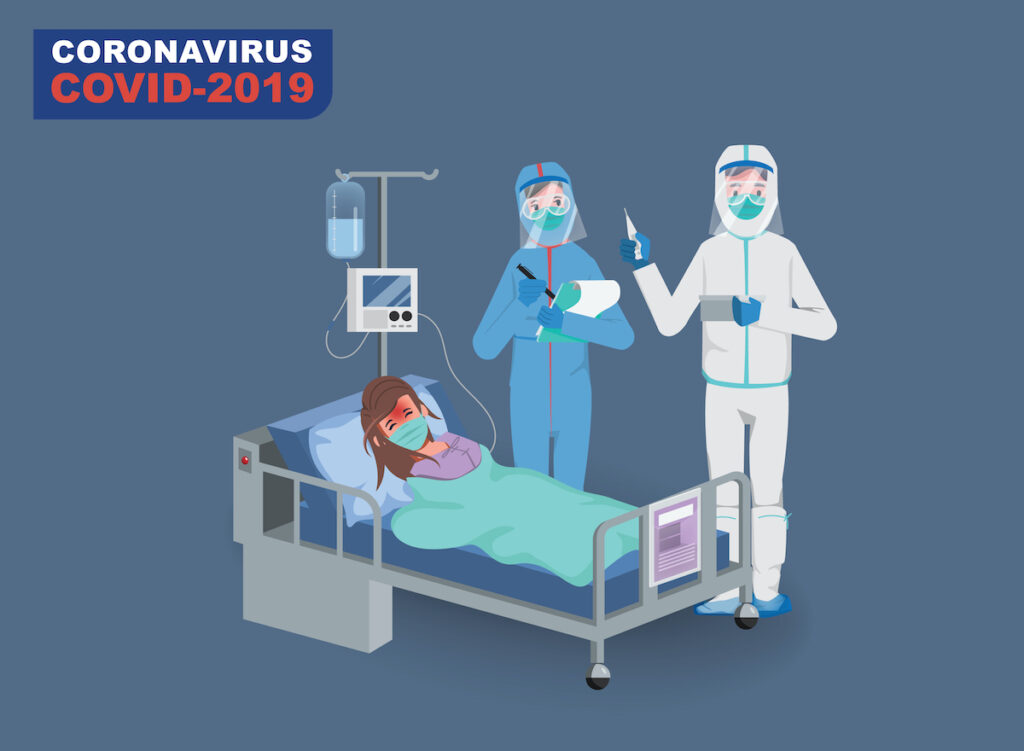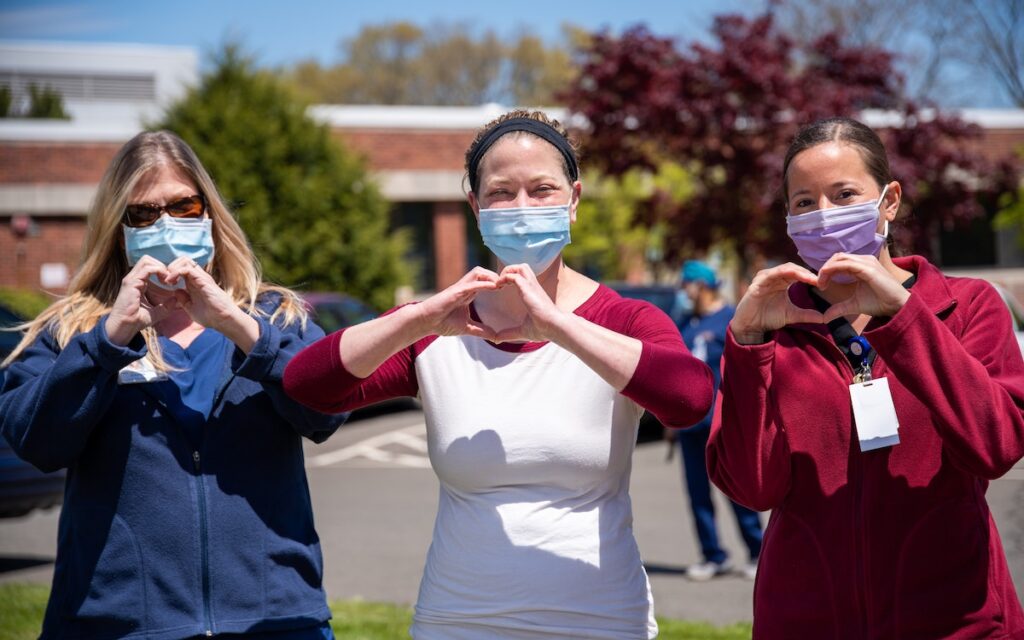
The COVID-19 pandemic has brought on an unprecedented surge in critical care patients admitted to acute hospitals. Consequently, staff working in intensive care units (ICUs) have been overwhelmed with increased workloads and a variety of challenges.
Frontline healthcare workers have to face extended periods of potential exposure to the virus, alongside fears of contracting and spreading it to their loved ones (Hu et al., 2020; Urooj et al., 2020). Furthermore, they have to face the unpleasant reality of working so closely with the virus – the high mortality rate amongst COVID patients (WHO, 2020) and difficulty in providing adequate end of life support to patients and their loved ones are understandably distressing (Mohsin et al., 2020; Maguen & Price, 2020).
However, while we know of the psychological distress frontline workers experience from their work within the context of the pandemic (Greene et al., 2020; Lai et al., 2020; Rossi et al., 2020) we still don’t know how often this manifests into mental health disorders within ICU staff. Greenberg and colleagues (2020) aimed to fill this evidence gap by investigating the rates of probable mental health disorders in ICU and anaesthetic staff.

Frontline healthcare workers, and ICU staff, in particular, have been under unprecedented amounts of pressure during the COVID-19 pandemic. So how often does this lead to mental illness?
Methods
As part of a service evaluation, Greenberg et al. (2020) collected data in June and July of 2020 via an anonymised brief online survey from ICUs across 6 NHS hospitals with a bed occupancy ranging from 10-75 critically ill COVID patients. The ICUs included were identified through ICNARC (Intensive Care National Audit and Research Centre) data and local ICU reporting systems. The survey included questions from an array of standardised questionnaires, including:
- The Generalised Anxiety Disorder (GAD) Scale to measure anxiety
- The Patient Health Questionnaire (PHQ-9) to measure depression and thoughts of self-harm/suicidal ideation
- The Post-traumatic stress disorder checklist (PCL-6) civilian version to measure PTSD
- The AUDIT-C to measure alcohol consumption
- The Warwick Edinburgh mental wellbeing scale (WEMWBS) to examine both feelings and functioning aspects of mental wellbeing.
The authors conducted bivariate correlations to examine the relationship between different mental health measure scores. They also used logistic regression analyses to investigate differences in scores across the different professions in the ICU (e.g., doctors vs. nurses).
Results
The sample included 709 healthcare professionals. Of those, 291 (41%) were doctors, 344 (48.5%) were nurses and 74 (10.4%) were in other clinical roles.
While the majority of participants (N=415; 58.8%) reported good wellbeing, almost half (N=322; 45.4%) met the criteria for at least one of the following mental health disorders: PTSD (39.5%), severe anxiety (11.3%), problem drinking (7.2%) or severe depression (6.3%). 13.4% of the sample also reported having experienced thoughts of self-harm or sentiments of being “better off dead” within the past two weeks.
The authors also state that while doctors were more likely to report good wellbeing, nurses were more likely to meet the thresholds for PTSD, anxiety, and depression. Thoughts of self-harm and suicidal ideation were also reported in a significantly higher proportion of nurses compared to doctors or other clinical staff (19.2% vs 7.6% and 9.5% respectively).
In their investigations of the relationship between different mental health measure scores, the authors reported that higher scores on the WEMWBS, which measures mental wellbeing, were significantly associated with lower scores on all other outcome measures. They also found that measures of anxiety, depression, and PTSD symptoms were all significantly correlated with each other. However, there were no significant associations between any measure of poor mental health and alcohol consumption.

This study by Greenberg and colleagues suggests that nearly half of the sampled healthcare professionals surveyed, self-reported symptoms that met the criteria for at least one mental health condition.
Conclusions
Staff working in ICUs reported high rates of probable mental illness and thoughts of self-harm, with 45% reporting symptoms of PTSD, severe depression, or a severe anxiety disorder. These mental health difficulties were especially prevalent in nurses. Those that met the threshold for one probable mental disorder were also considerably more likely to meet the threshold for another.

The results indicate that ICU staff, and particularly nurses, experienced high rates of probable mental illness and thoughts of self-harm.
Strengths and limitations
This study has several strengths:
- Firstly, their inclusion of a range of NHS acute trusts across the UK, including both teaching and district general hospitals meant that they likely included a range of participants and experiences within their findings.
- Secondly, the anonymisation of the survey they used reduced the risk of social desirability biases affecting participants’ responses.
- Thirdly, the inclusion of a variety of ICU staff allowed the authors to briefly examine differences across professions.
- Finally, the use of validated measures to assess the mental health outcomes of interest means that we can be relatively certain that the authors are truly measuring what they set out to, and in turn, that inferences and conclusions made based on these scores are valid (Murphy & Davidshofer, 2001; Tsang et al., 2017)
However, there were also several limitations:
- The lack of demographic information means that the authors were unable to identify any other factors that may be associated with the high rates of probable mental disorders. For example, nurses in the UK are more likely to be young females (NMC, 2018), a group that is more likely to experience mental health difficulties (SAMHSA, 2020). Therefore, it’s difficult to ascertain whether these elevated rates are linked to some characteristic of the profession, or to the demographic.
- In addition, the use of self-report measures rather than gold-standard diagnostic interviews raises potential issues, such as participants misremembering their affective experiences when asked to look back on how they’ve been feeling (Lucas, 2018).
- Moreover, the lack of random selection may mean that a response bias has occurred, wherein individuals who were experiencing salient mental health difficulties were more likely to participate. It also means that these findings are not generalisable outside of this staff group.
- There is some ambiguity regarding their finding on self-harm; it’s unclear how common thoughts of self-harm are in ICU staff in general, so we can’t really tell if this is an elevated rate in comparison to pre-COVID.
- Finally, at the time this blog was written, this study was yet to be peer-reviewed, which is a process intended to ensure the quality, validity, significance, and originality of the study (Kelly et al., 2014).

While this study had several strengths, the lack of demographic information makes it difficult to ascertain whether any other factors are driving the association with high rates of mental health disorders.
Implications
Where can research go from here?
Future studies should strive to carry out random selection when conducting research of this nature, which would allow greater generalisability of the findings. Furthermore, there is a need to gather demographic information, so that we can have a better understanding of which factors really influence the rates of probable mental disorders seen in ICU staff. Lastly, to untangle why we might be seeing differences across professions in the ICU, it may be beneficial to conduct qualitative research on the matter to explore differences in their experiences. The rich nature of qualitative data allows us to gain valuable insight into the complex nature of human experiences, which can, in turn, help us to form hypotheses that can later be tested through quantitative research such as in this study (Agius, 2013). For example, in a previous blog I wrote for the Mental Elf on a study by Fox et al. (2020) on the link between PTSD and increased suicide rates in the general population, I expressed concern over potential PTSD and suicidality in frontline workers during COVID-19. This was based on qualitative research I had done with UCL’s COVID Trauma Working Response Group on frontline healthcare workers. This is now backed up by Greenberg and colleagues’ (2020) findings.
How can we use these findings in clinical practice?
The importance of providing frontline staff with appropriate and timely psychosocial support cannot be stressed enough. Although my personal belief is that we should be striving to provide support to anyone who needs it, it may be more compelling to naysayers to keep in mind that there’s evidence that poor mental health is associated with functional impairment (Tay et al., 2019; Rona et al., 2009), which can, in turn, put patients at risk. But how can we counteract this negative impact on frontline health workers’ mental health?
- Put systems in place within NHS trusts wherein managers prioritise the provision of evidence-based support for their workers.
- This should include thorough monitoring of staff mental health, which would in turn aid in the prevention of the cascade of mental health difficulties through early intervention.
- We also need to ensure that frontline workers can access formal treatment in a timely manner, rather than finding themselves stuck on never-ending waitlists.
- However, as we can’t deny the existence of long waitlists, it may be beneficial to provide staff with psychoeducation, so that they can learn the skills to monitor and manage their own mental health, as well as know where they can go for help.
- In my research with frontline healthcare workers, they have often spoken about how they tend to rely on one another for support (Billings et al., 2020), and therefore there may be value in training staff themselves in mental health first aid so that they can be better equipped to support one another.

It is vital that systems are put in place to provide ICU staff with the necessary psychosocial supports and psychological first aid training.
Statement of interests
None.
Links
Primary paper
Greenberg N., Weston D, Hall C. et al. (2020). The mental health of staff working in intensive care during COVID-19. medRxiv 2020.11.03.20208322.
Other references
Agius, S.J. (2013). Qualitative research: its value and applicability. The Psychiatrist 37, 204-206. Doi: 10.1192/pb.bp.113.042770
Billings J., Abou Seif N., Hegarty S. et al (2020). What support do frontline workers want? A qualitative study of health and social care workers’ experiences and views of psychosocial support during the COVID-19 pandemic. medRxiv 2020.11.05.20226522.
Fox V., Dalman C., Dal H., et al. (2020). Suicide risk in people with post-traumatic stress disorder: A cohort study of 3.1 million people in Sweden. Journal of Affective Disorders, 279, 609-616.
Greene T., Harju-Seppänen J., Adeniji M. et al (2021). Predictors and rates of PTSD, depression and anxiety in UK frontline health and social care workers during COVID-19. European Journal of Psychotraumatology 12(1).
Hu D., Kong Y., Li W. et al (2020). Frontline nurses’ burnout, anxiety, depression, and fear statuses and their associated factors during the COVID-19 outbreak in Wuhan, China: A large-scale cross-sectional study. E-Clinical Medicine, 24, 100424. DOI:
Kelly J., Sadeghieh T. & Adeli K. (2014). Peer Review in Scientific Publications: Benefits, Critiques, & A Survival Guide. eJIFCC, 25(3), 227-243.
Lai J., Ma S., Wang Y. et al (2020). Factors associated with mental health outcomes among health care workers exposed to coronavirus disease. JAMA Network Open, 3(3), e203976.
Lucas R.E. (2018). Reevaluating the strengths and weaknesses of self-report measures of subjective well-being. In E. Diener, S. Oishi, & L. Tay (Eds.), Handbook of well-being. Salt Lake City, UT: DEF Publishers.
Maguen S. & Price M (2020). Moral injury in the wake of coronavirus: Attending to the psychological impact of the pandemic. Psychological Trauma: Theory, Research, Practice, and Policy, 12(S1), S131–S132.
Mohsin A.K.M., Hongzhen L., Sume A.H. et al (2020). Analysis of the causes of moral injury in the outbreak of 2019-nCoV. Psychological Trauma: Theory, Research, Practice, and Policy, 12(S1), S162-S164.
Murphy KR & Davidshofer CO (2001). Psychological Testing: Principles and Applications. Upper Saddle River, NJ: Prentice Hall.
Nursing & Midwifery Council (NMC). (2018). Annual equality, diversity and inclusion report 2017-2018. Retrieved from annual-edi-report-2017-18.pdf (nmc.org.uk).
Rona R.J., Jones M., Iversen A. et al (2009). The impact of posttraumatic stress disorder on impairment in the UK military at the time of the Iraq war. Journal of Psychiatric Research, 43, 649-655.
Rossi R., Socci V., Pacitti F. et al (2020).Mental Health Outcomes Among Frontline and Second-Line Health Care Workers During the Coronavirus Disease 2019 (COVID-19) Pandemic in Italy. JAMA Network Open, 3(5), e2010185.
Substance and Mental Health Services Administration. (2020). Key substance use and mental health indicators in the United States: Results from the 2019 national survey on drug use and health. Last Accessed: 15 March 2021.
Tay A.K., Rees S., Miah M.A.A., et al (2019). Functional impairment as a proxy measure indicating high rates of trauma exposure, post-migration living difficulties, common mental disorders, and poor health amongst Rohingya refugees in Malaysia. Translational Psychiatry, 9, 213.
Tsang S., Royse C.F. & Terkawi A.S (2007). Guidelines for developing, translating, and validating a questionnaire in perioperative and pain medicine. Saudi Journal of Anaesthesia, 11(Suppl1), S80-S89.
Urooj U., Ansari A., Siraj A. et al (2020). Fears and Perceptions of doctors during Covid-19 Pandemic. Pakistan Journal of Medical Sciences, 36(COVID19-S4), COVID19-S37-S42.
World Health Organisation (2020). Coronavirus (COVID-19) events as they happen. Retrieved 3 March 2021.
Photo credits
- Photo by Vladimir Fedotov on Unsplash
- Photo by Rusty Watson on Unsplash
- Photo by Aarón Blanco Tejedor on Unsplash

Hi Nada!
These have been real challenging times, which have impacted everyone of us. But definitely the negative impact on the health workers is a lot more than the ones on any other profession.